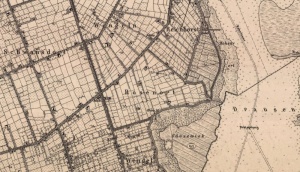Wengeln (Warmian-Masurian Voivodeship, Poland)
Wengeln (also known as Wieben and Wengel; now known as Węgle; coordinates: 54.094, 19.447 [54° 6′ 10″ N, 19° 0′ 0″ E]; population in 1905, 167; in 2013, 130) is located approximately 9 kilometers (5.5 miles) southeast of Elbląg (Elbing), 25 km (16 miles) southeast of Nowy Dwór Gdański (Tiegenhof), and 27 km (17 miles) north-east of Malbork (Marienburg). It is located on the western shore of Lake Druzno (Drausen See).
Wengeln was founded in 1557 by Dutch settlers. In 1604 some Hutterian Brethren of Moravia sought permission to settle in Elbing, West Prussia. They had a lengthy talk with the mayor and the councilors, but in spite of the intercession of the Mennonites their petition was refused. They then settled in Wengeln, rented nine hides of land, and lived there under the protection of the Polish government according to the dictates of their conscience. In spite of protest by the Elbing city council, they were not molested. In the course of time this settlement was absorbed into the Mennonite settlement.
Until 1772 Wengeln was located in what was known as Royal Prussia (also known as Polish Prussia) in the Kingdom of Poland. The First Partition of Poland in 1772 resulted in the creation of a new province in 1773, called West Prussia, in which Wengeln was located. The village was situated in the district (Kreis) of Marienburg until the end of World War I, when it came under the jurisdiction of the German province of East Prussia. At the outbreak of World War II in 1939, it came under the control of Nazi Germany. In February 1945 it was occupied by Soviet forces and eventually returned to Poland. In 2012 Węgle, along with Żukowo (Reichhorst) was a village in the administrative district of Gmina Markusy, within Elbląg County, Warmian-Masurian Voivodeship.
The Prussian census of 1776 lists 18 Mennonite families in Wengeln with the following surnames: Albrecht, Dau, Ens, Friesen, Froes, Froesen, Funck, Goertzen, Harms, Jantzen, Lammert, Pauls, Penner, and Quiring. In 1820, Wengeln had 95 residents, including 64 Mennonites.
Mennonites who were residents of Wengeln were members of the Thiensdorf-Markushof Mennonite Church.
Bibliography
Hege, Christian and Christian Neff. Mennonitisches Lexikon, 4 vols. Frankfurt & Weierhof: Hege; Karlsruhe: Schneider, 1913-1967: v. IV, 493.
Neubaur, L. "Mahrische [Hutterite] Brüder in Elbing." Zeitschrift für Kirchengeschichte (1912): 447-55.
Stowarzyszenie Konserwatorów Zabytków. "Węgle - Żukowo" Catalogue of Monuments of Dutch Colonization in Poland. 2005. Web. 17 February 2013. http://holland.org.pl/art.php?kat=obiekt&id=467&lang=en.
Wikipedia. "Węgle-Żukowo." Web. 17 February 2013. http://en.wikipedia.org/wiki/Węgle-Żukowo.
Wolf, Hans-Jürgen. "Familienforschung in Westpreußen." Web. 17 February 2013. http://www.westpreussen.de/cms/ct/ortsverzeichnis/details.php?ID=6859.
Maps
Map:Węgle-Żukowo, Warmian-Masurian Voivodeship, Poland
| Author(s) | Wilhelm Wiswedel |
|---|---|
| Richard D Thiessen | |
| Date Published | February 2013 |
Cite This Article
MLA style
Wiswedel, Wilhelm and Richard D Thiessen. "Wengeln (Warmian-Masurian Voivodeship, Poland)." Global Anabaptist Mennonite Encyclopedia Online. February 2013. Web. 16 Apr 2024. https://gameo.org/index.php?title=Wengeln_(Warmian-Masurian_Voivodeship,_Poland)&oldid=146332.
APA style
Wiswedel, Wilhelm and Richard D Thiessen. (February 2013). Wengeln (Warmian-Masurian Voivodeship, Poland). Global Anabaptist Mennonite Encyclopedia Online. Retrieved 16 April 2024, from https://gameo.org/index.php?title=Wengeln_(Warmian-Masurian_Voivodeship,_Poland)&oldid=146332.
©1996-2024 by the Global Anabaptist Mennonite Encyclopedia Online. All rights reserved.
